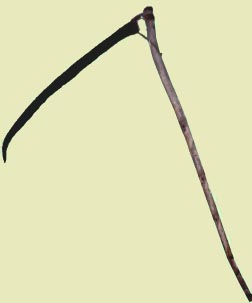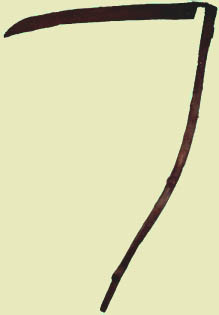Scythes (leys)
Working with the scythe

The scythe is known as a "ley" in the Lake District and this long bladed tool has been used for cutting grass for hay, oats or barley for animal and human food, and bracken for bedding. The shaped wooden handle is known as a "sned".
A scythe needs to be fitted to the user so it does not have to be lifted much for use. David Trotter recalls: "You could adjust the handles, they had like a wing nut on. You could drop the ley or alter it just as you needed."
Ley is sometimes pronounced "laithe". The other meaning of "ley" or "lea" is a field covered with grass or herbage and suitable for grazing by livestock.
Straight or curved
The popular image of the scythe is of the type with a curved sned, or snaith. However, it is a southern version of the tool. The older northern version has a straight sned. This example has no handles attached.
Traditionally the scythe is a man's tool, while the wooden hay rake is thought of as a woman's tool.
John Gate recalls:"Now when we went to farm in Mosedale (1930s), there was two or three o’ these lying on t’ wall tops and up in t’ barn. You know the shaped sned on a scythe? well these were straight. They must ha’ gone out o’ fashion."

Sickles vs. scythes
The scythe has been used since Roman times to mow hay. The scythe was faster, more comfortable and more efficient to use than the ancient, short handled, curved, serrated blade sickle. The sickle needed the user to bend much closer to ground level (though grain crops had not yet been bred down to the modern shorter stalks). The scythe mainly replaced the sickle during the 1850s in Cumbria, but it was in use earlier in some places. Garnett (1910) quotes a sale of the effects of Wm Hawkrigg, Yeoman, of Underhelm, Grasmere, held in 1710: as well as an "oxe-yoak" he had owned "a syth and strickle (not a sickle, but the sharpening tool for the scythe), a sledge, two ffawing spades and a peat spade, sickles, a tarr kett (kettle) and tarr costrell" and pewter dishes.
The straight scythe is older than the S shaped scythe, and it survived longer in Northern England than in the South. In other areas of Britain, the long handled scythe became the tool of choice for wheat and other crop harvesting in the early 1800s. In Cumbria the back-breaking sickle stayed in favour for a long time because it was the tool of the itinerant Irish workers who "followed the harvest" from the early areas such as the Solway, Eden valley and South Lakeland up into the later hill farm harvest.
Quantity
A man with a scythe could cut up to 2 acres of oats or wheat a day; barley took a little longer because it dulled the blade faster. The scythe itself was superseded in the later years of the 19th century by the horsedrawn mowing machine, although it was still common to "open out" the margins of fields of grass or corn by using a scythe in front of the large machine, and, as we have seen in other pages, the scythe was still used to mow awkward areas that could not be got mechanically.
Costs
The Penrith newspaper reported in July 1902 that "in the vicinity of Kirkby Stephen the bulk of the hay had been secured and considerable inroads had been made into crops on outlying farms. At the haytime hirings, a few Irish labourers offered their services and good workers could command £6 or £7 for the month."
John Gate, about the 1930s: "Them old men, when they went to cut a field of hay, three or four of them, it was so much money pay for cutting a field, and so much ale. Geyley often though, they’d send a man to t’ pub for ale and he wouldn’t return!"